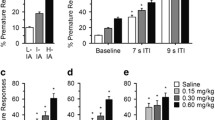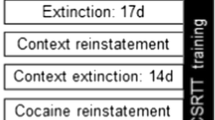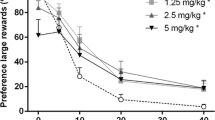Abstract
Rationale
Impulsive behaviour is a component of psychiatric disorders such as bipolar disorder, attention deficit hyperactivity disorder (ADHD), or personality disorders. Most experimental studies on impulsive behaviour punish impulsive choices by loss or delay of reward. In the present study, impulsive behaviour was punished by an explicitly aversive stimulus, using a novel fixed consecutive number (FCN) schedule of electric shock avoidance.
Objectives
This study was conducted to demonstrate stable performance using the FCN avoidance procedure, and examine the effects of drugs previously shown to affect impulsive behaviour using a conventional FCN schedule.
Methods
First, rats were trained in the appetitive FCN procedure. Pressing the right lever in an operant conditioning chamber after having pressed the left lever at least six times delivered a food pellet (FCN6). Responses on the right lever before completing this ratio resulted in a time out and restarted the ratio. The rats were then switched to FCN avoidance. Responses on the right lever made before completion of the ratio also resulted in food delivery, but were accompanied by an electric shock.
Results
Chlordiazepoxide (10.0 mg/kg), ethanol (1.0 g/kg), and haloperidol (0.1 mg/kg) increased impulsive behaviour by reducing the number of left lever responses made before the right lever was pressed. Imipramine (1.0–10.0 mg/kg) and desipramine (1.0–10.0 mg/kg) had no effect on impulsive choice. Amphetamine (0.4 and 0.8 mg/kg) and methylphenidate (6.0 mg/kg) significantly increased the mean chain length, and the proportion of very long chains, indicative of reduced impulsivity, although this did not improve efficiency.
Conclusions
The increases in impulsivity produced by chlordiazepoxide, ethanol, and haloperidol were similar to those under appetitive FCN schedules. In contrast, amphetamine and methylphenidate, by reducing impulsivity in the FCN avoidance, induced effects opposite to those observed in an appetitive FCN procedure. These results suggest that the therapeutic actions of stimulants, to reduce impulsive behaviour in ADHD, may arise in part by increasing the control of behaviour by aversive stimuli.



Similar content being viewed by others
References
Cardinal RN, Robbins TW, Everitt BJ (2000) The effects of d-amphetamine, chlordiazepoxide, α-flupenthixol and behavioural manipulations on choice of signalled and unsignalled delayed reinforcement in rats. Psychopharmacology 152:362–375
Evenden JL (1991) Effects of chlordiazepoxide, morphine and amphetamine on responding suppressed by different levels of electric shock in the pigeon are rate dependent. Psychopharmacology 105:253–258
Evenden JL (1998a) The pharmacology of impulsive behaviour in rats II: the effects of amphetamine, haloperidol, imipramine, chlordiazepoxide and other drugs on fixed consecutive number schedules (FCN8 and FCN 32). Psychopharmacology 138:283–294
Evenden JL (1998b) The pharmacology of impulsive behaviour in rats III: the effects of amphetamine, haloperidol, imipramine, chlordiazepoxide and ethanol on a paced fixed consecutive number schedule. Psychopharmacology 138:295–304
Evenden JL (1998c) The pharmacology of impulsive behaviour in rats IV: the effects of selective serotonergic agents on a paced fixed consecutive number schedule. Psychopharmacology 140:319–330
Evenden JL (1999) Varieties of impulsivity. Psychopharmacology 146:348–361
Evenden J, Meyerson B (1999) A comparison of the behavior of spontaneously hypertensive rats and Wistar Kyoto rats under a paced fixed consecutive number schedule of reinforcement. Pharmacol Biochem Behav 63:71–82
Evenden JL, Ryan CN (1996) The pharmacology of impulsive behaviour in rats: the effects of drugs on response choice with varying delays of reinforcement. Psychopharmacology 128:161–170
Geller I, Kulak JT, Seifter J (1962) The effects of chlordiazepoxide and chlorpromazine on a punishment discrimination. Psychopharmacologia (Berl) 25:112–116
Hill RT (1970) Facilitation of conditioned reinforcement as a mechanism of psychomotor stimulation. In: Costa ER, Garatini S (eds) Amphetamines and related compounds. Proceedings of the Mario Negri Institute for Pharmacological Research, Milan, Italy. Raven Press, New York, pp 781–795
Killcross AS, Everitt BJ, Robbins TW (1997) Symmetrical effects of amphetamine and alpha-flupenthixol on conditioned punishment and conditioned reinforcement: contrasts with midazolam. Psychopharmacology 129:141–152
Ko T, Duncan B, Evenden JL (2003) The effects of anxiolytic and psychotomimetic drugs on punished and unpunished responding maintained by fixed interval schedules of reinforcement. Soc Neurosci Abstr 33:959.9
Laties VG (1972) The modification of drug effects on behavior by external discriminative stimuli. J Pharmacol Exp Ther 183:1–13
Logue AW (1988) Research on self-control: an integrating framework. Behav Brain Sci 11:665–709
Maidment ID (2003) The use of antidepressants to treat attention deficit hyperactivity disorder in adults. J Psychopharmacol 17:332–336
Mechner F, Latranyi M (1963) Behavioural effects of caffeine, methamphetamine and methylphenidate in the rat. J Exp Anal Behav 6:331–342
O’Donnell JM, Seiden LS (1983) Differential-reinforcement-of-low-rate 72 second schedule: selective effects of antidepressant drugs. J Pharmacol Exp Ther 224:80–88
Robbins TW (1975) The potentiation of conditioned reinforcement by psychomotor stimulant drugs: a test of Hill’s hypothesis. Psychopharmacologia (Berl) 45:103–115
Robbins TW (1981) Behavioural determinants of drug action: rate-dependency revisited. In: Cooper SJ (ed) Theory in psychopharmacology, vol 1. Academic Press, London, pp 2–63
Solanto MV (1998) Neuropsychopharmacological mechanism of stimulant drug action in attention-deficit hyperactivity disorder: a review and integration. Behav Brain Sci 94:127–152
Solanto MV (2002) Dopamine dysfunction in AD/HD: integrating clinical and basic neuroscience research. Behav Brain Sci 130:65–71
Spealman RD (1979) Comparison of drug effects on responding punished by pressurized air or electric shock delivery in squirrel monkeys: pentobarbital, chlordiazepoxide, d-amphetamine and cocaine. J Pharmacol Exp Ther 209:309–315
Taylor J, Robbins TW (1984) Enhanced behavioural control by conditioned reinforcers following microinjections of d-amphetamine into the nucleus accumbens. Psychopharmacology 84:405–412
Wilens TE, Biederman J, Prince J, Spencer TJ, Faraone SV, Warburton R, Schleifer D, Harding M, Linehan C, Geller D (1996) Six-week, double-blind, placebo-controlled study of desipramine for adult attention deficit hyperactivity disorder. Am J Psychiatry 153:1147–1153
Acknowledgements
We would like to thank the vivarium staff at AstraZeneca R & D Wilmington for their assistance in the care of the animals. We would like to thank Dan Widzowski, Gennady Smagin, Jim Doherty, and Tim Piser for their comments on the manuscript.
Author information
Authors and Affiliations
Corresponding author
Rights and permissions
About this article
Cite this article
Evenden, J., Ko, T. The psychopharmacology of impulsive behaviour in rats VIII: effects of amphetamine, methylphenidate, and other drugs on responding maintained by a fixed consecutive number avoidance schedule. Psychopharmacology 180, 294–305 (2005). https://doi.org/10.1007/s00213-005-2163-0
Received:
Accepted:
Published:
Issue Date:
DOI: https://doi.org/10.1007/s00213-005-2163-0




